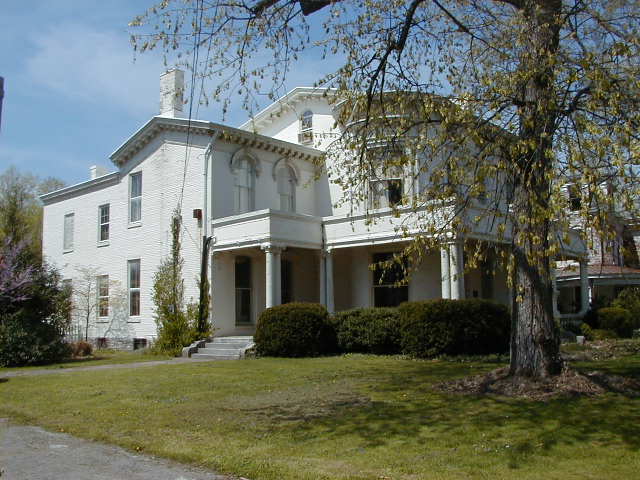
The Martin Luther King Neighborhood, bordered by Elm Tree Lane, Short, Sixth, and North Limestone Streets, is a neighborhood full of history located in the eastern part of downtown Lexington.
The highlight of the neighborhood is the recently renovated Lyric Theater. Located at the corner of Third and Deweese Streets, the Lyric originally opened as a movie house in 1948. During the 1950’s though, the movie house moved more towards musical acts such as the legendary B.B. King, Cab Calloway, and Ella Fitzgerald. The Lyric’s decline began with the integration of Lexington’s other theaters and eventually closed in 1963. In October 2010, the Lyric reopened and is now host to a variety of community events (http://www.lexingtonlyric.com/category/events).
Another center of activity in the neighborhood is the Kinkead House, located at 362 North Martin Luther King, Jr. Boulevard. One of the few antebellum mansions remains within the original boundaries of Lexington. The home was built in the late 1840’s as a Greek Revival townhouse, but was converted to the Italianate style after 1853. In 1981, members of the Kinkead family donated the house to the Living Arts and Science Center. The center presents more than 400 art classes and workshops every year for children 18 months and older and adults, 6-8 art exhibits, field trips for over 6000 students, monthly Discovery night programs, community arts projects, numerous free and low-cost family events, and ongoing free art classes for thousands of at-risk, special needs, and underserved children, teens, and adults. The LASC is dedicated to making participation in the arts available to everyone and provides programming at the center, schools, community centers, libraries, hospitals, parks, and other facilities. A schedule of their events can be found at http://www.lasclex.org/index.php.
The Kinkead House is not the only contribution the Kinkead family made to this neighborhood. The area formerly composed of Illinois, Kinkead, and Mosby Streets made up Kinkeadtown, a neighborhood developed for African American in 1869-70 by abolitionist George B. Kinkead. Kinkead was a wealthy landowner, lawyer, and Transylvania College graduate. After the Civil War, many slaves migrated from rural areas into the city. Unfortunately, there was little choice for where they could live. Kinkead, who sympathized with the plight of the newly freed slaves, acquired 11 acres of property adjacent to his estate and made it available to African Americans who met certain qualifications for home ownership. The homes built on this land were primarily shotgun and T-plan houses, but during the extension of Rose Street in 1991-1992, the area was completely demolished. In 1992, UK conducted and excavation in the neighborhood to try to learn more about the urban life of African Americans in the late 19th and early 20th centuries. Since then, a new development of affordable, owner-occupied houses now fills the 400 block of Elm Tree Lane.
Another building of note in the neighborhood is the Lord Morton House located on Fifth Street, between North Limestone and North martin Luther King, Jr. Boulevard. William “Lord” Morton, a successful Lexington businessman, built this Federal style house in 1810. From 1838-1858, the famous abolitionist Cassius M. Clay lived here. It was later owned by the Duncan family, but in 1913 the city acquired the property and proceeded to turn the land into a public park that was, at that time, part of the segregated park system. Today, the Morton House is in active use as The Nest, Center for Women, Children, and Families (http://www.thenestlexington.org).
Park spaces can also be found in the area. Just past Third Street on Elm Tree Lane is the Old Episcopal Burying Ground. Christ Episcopal Church purchased the land in 1832 as a burial place. During the cholera epidemic in 1833, the cemetery became especially important as nearly a third of the Christ Episcopal Church parishioners were buried here in that year. It was in this cemetery that William “King” Solomon buried many bodies no one else would, elevating him to hero status. Many prominent Kentuckians are buried here including Mathias Sherlock, father of Kentucky architecture; Colonel George Nicholas, father of Kentucky’s constitution and the state’s first attorney general; and the family of Colonel Thomas Hart, father-in-law to statesman Henry Clay and a member of the Transylvania Company that opened Kentucky up to settlement in the 1770s. The cemetery is not regularly open to visitors, but private tours can be set up by calling 859-254-2948.
A park open at all times in the area is Labyrinth Park. This park is the site of an 1812 Catholic Church no longer in existence. The land was used as a cemetery from 1833-1836. Most of the cemetery remains buried under sod, but small amount has been uncovered. The Christ Episcopal Church now owns the park and has added a walking labyrinth that replicates the floor pattern of the cathedral at Chartres, France.
The Church has also established a community garden in the area primarily used to grow vegetables for nearby residents and encourages the community’s participation in all parts of maintaining the garden, including planting, harvesting, preparing, and preserving. Hundreds of pounds of vegetables are given away annually to residents and community associations. In 2009, the garden was enlarged to included fruit trees and berry bushes.
This is truly a neighborhood full of surprises and secret spaces. The historic homes and buildings, churches, and cemeteries make it a key part in maintaining Lexington’s history. If you haven’t been to the Martin Luther King Neighborhood in a while, maybe it’s time for a second look!
Posted by Turf Town Properties on
Leave A Comment